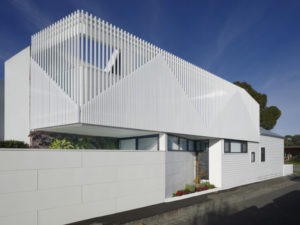Project Description
With every realisation of a project, the architect fundamentally interferes with the natural or urban environment. The site will never be the same as it was before the intervention. For this reason, the architect has an even greater responsibility for the space where the intervention is taking place.
In the case of House on Golo, which is situated in a picturesque location, overlooking the peaks of the Julian Alps and the Kamnik-Savinja Alps, the essential characteristics of the terrain are the colour and texture of the soil on which the house is built.
The structure of the house follows the tectonic layering of the terrain into which the construction pit was dug. With a careful casting of the concrete, coloured in the same shade as the autochtonous rocks and executed in separate layers, the house and its architecture replace what they have taken from nature during construction.
The house is positioned as a set of three volumes of different heights, which follow the topography of the terrain. The ground floor, spanning three slightly different levels, corresponds to the lifestyle of its users. The study room is located on the lowest of the three levels and represents the centre of the house. It ismade completely out of wood and serves as an atmospheric contrast to the fair-faced concrete walls and terrazzo floors of the rest of the living space. The concrete walls are designed as a background to the owners‘ collection of works of art.
The window has a dual role in architecture: on one hand it allows natural light into the interior and at the same time it directs views out towards the surroundings. The same is true for House on Golo, since the rhythm of the window openings is carefully arranged to frame the views towards the Alps. It is also the reason for the seemingly random layout of the windows on the façade.
























































